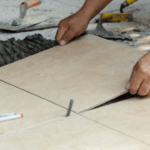If you want to enhance the beauty and longevity of your bathroom tiles, sealing the grout is a crucial step.
Over time, grout can become discolored, porous, and susceptible to moisture, which can lead to mold and mildew growth.
By following these 7 simple steps, you can effectively seal the tile grout in your bathroom and give your space a fresh and revitalized look.
Table of Contents
- Introduction
- Gather Your Materials
- Clean the Grout Lines
- Allow the Grout to Dry
- Apply the Grout Sealer
- Wipe Off Excess Sealer
- Final Drying and Inspection
- Conclusion
Introduction
Sealing tile grout might sound like a daunting task, but it’s a relatively straightforward process that can yield remarkable results.
Not only does it protect the grout from moisture and stains, but it also adds a polished finish to your bathroom.
Gather Your Materials
Before you begin, make sure you have all the necessary materials on hand. You’ll need a grout sealer, a small paintbrush or roller, clean rags, and some disposable gloves to protect your hands.
Clean the Grout Lines
Start by thoroughly cleaning the grout lines. Use a mixture of water and a mild detergent to remove any dirt, grime, or soap scum. A small scrub brush or an old toothbrush can be handy for reaching into tight spaces.
Allow the Grout to Dry
Once the grout lines are clean, give them ample time to dry. It’s essential that the grout is completely dry before applying the sealer to ensure proper adhesion.
Apply the Grout Sealer
Now comes the sealing process. Dip your paintbrush or roller into the grout sealer and apply it directly onto the grout lines.
Work in small sections to ensure even coverage. Be careful not to let the sealer come into contact with the tile surfaces.
Wipe Off Excess Sealer
After applying the sealer, wait for a few minutes as the grout absorbs it. Then, take a clean, dry rag and gently wipe off any excess sealer that might be sitting on the tile surfaces. This step helps prevent a hazy residue from forming.
Final Drying and Inspection
Allow the sealer to dry for the recommended time mentioned on the product label. Once dry, inspect the grout lines for any missed spots or uneven coverage. If needed, apply a second coat following the same process.
Conclusion
Sealing the tile grout in your bathroom is a simple yet impactful way to improve the appearance and durability of your space.
By following these 7 steps, you can seal the grout effectively, safeguarding it against moisture and maintaining its pristine look.
FAQs
Q1: How often should I seal my bathroom tile grout?
Ans – It’s generally recommended to reseal bathroom tile grout every 1 to 3 years, depending on factors like usage and cleaning routine.
Q2: Can I use the same sealer for both floor and wall tiles?
Ans – Yes, the same grout sealer can typically be used for both floor and wall tiles. Just ensure that the sealer is suitable for your specific type of tile.
Q3: Is there a specific time of day that’s best for sealing grout?
Ans – Sealing grout is best done when the room is well-ventilated and at a moderate temperature. Avoid sealing during extremely humid conditions.
Q4: Can I walk on the tiles immediately after sealing the grout?
Ans – It’s recommended to wait at least 12 to 24 hours after sealing before walking on the tiles to ensure that the sealer has properly cured.
Q5: Can I use a spray-on sealer for grout?
Ans – Yes, spray-on grout sealers are available and can be convenient to apply. Just ensure even coverage and wipe off excess as needed.










